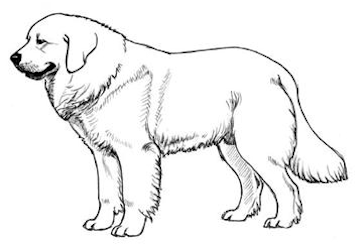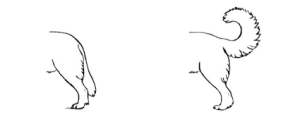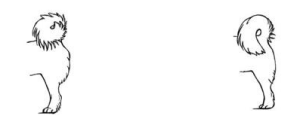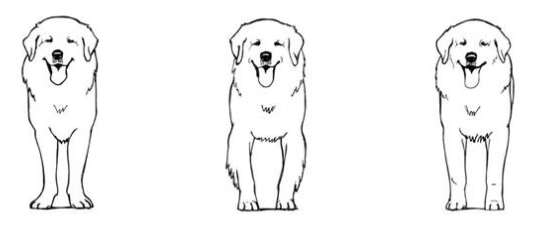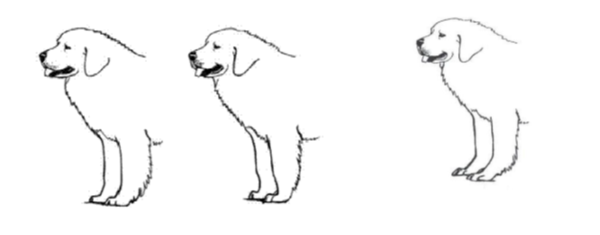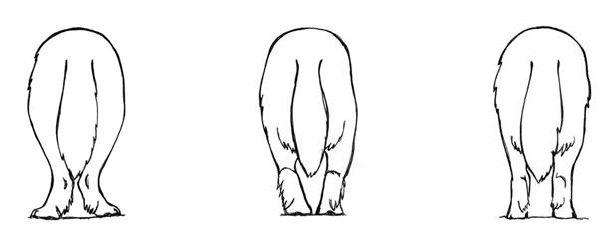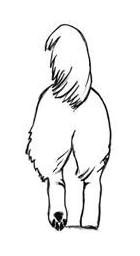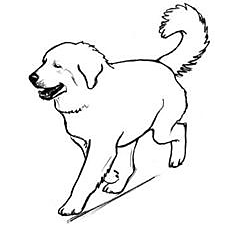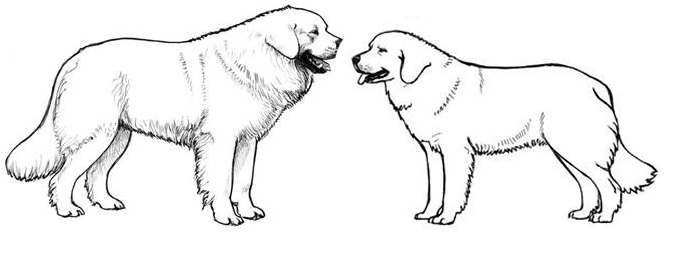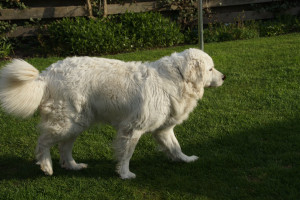
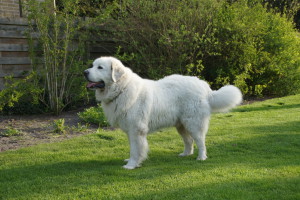
This text presents the current standard of the breed as well as some drawings and comments on it. Comments were prepared by breed judges from the country of origin and shall be considered the official document issued by the Polish Kennel Club. Apart from presenting brief historical summary of the origin of the breed it attempts the clarification of different parts of the standard (FCI Standard Nr 252 published on 08.06.1988 and translated into Polish). late dr Derezinski and experienced breeders. As a judge has only 4 or 5 minutes to assess any given dog in the show ring, these comments will be hopefully a usefull tool to proper evaluation. Judging is first and foremost the art of evaluating the dogs and choosing the best specimens. However, it is of utmost importance that the best specimens represent the correct breed type, in accordance to breed traditional utility and its preserved characteristics.
FCI Standard No 252
TATRA SHEPHERD DOG
(Polski Owczarek Podhalański)
Origin: Poland.
Date of publication of the original valid standard: 08.06.1988
Utilization: Herder and watchdog. Its imposing attitude and beautiful appearance make it a good companion dog.
Tatra shepherds have been traditionally used as flock guards, protecting sheep grazing in mountain pastures against big predators and thieves. Nowadays they are mostly bred as guards and companions, also in the lowlands. They can be successfully trained as guide dogs for blinds and used in dogotherapy and rescue work. They are obedient, protective and caring, especially when working with disabled people.
Classification FCI: Group 1 – Sheepdogs and Cattledogs (except Swiss Mountain and Cattledogs).
Section 1 – Sheepdogs. Without working trial.
This standard was eventually accepted by FCI on August 29th, 1967 (number 252a). Small changes were introduced in 1973 and 1985 (252b). The current breed standard comes from 1988 (June 8th).
The first pedigree litter was born in 1957; interestingly, it was bred in the coastal town of Łeba by dr Danuta Hryniewicz, whose foundation stock dates from 1935. Nevertheless, the breeding centrę has been and still remains Podhale.
The breed club was founded in 1981 and for many years its chairman was dr Derezinski. His dedication and knowledge of the breed is unsurpassed. There are several breed clubs abroad: in Holland, Belgium, Germany and USA as well as breed sections in the bigger clubs.
- GENERAL APPEARANCE:
Of strong and compact build giving the impression of stamina and mobility.
While judging the Tatra Shepherd, its original working qualities must be considered most important. The Tatra Shepherd is an imposing strong and balanced dog. It must be strong and determined both for fighting predators and guarding. Its abundant, dense and insulating coat gives excellent protection against bad weather. The generał impression of the Tatra Shepherd suggests strength, stamina and certain aloofness.
Despite its mountainous origins, the breed thrives in all areas and conditions. Sex dimorphism is clearly visible, females being distinctly smaller and less powerful than males.
- IMPORTANT PROPORTIONS:
Rectangular in shape, the length of the body of males being a little shorter than that of bitches.

The length of the body (measured from point of shoulder to buttocks) to the height at withers is 10:9, females may be fractionally longer.
Short body usually results from short croup and is faulty.
The length of the head to the height at withers is 3.5:10.
The width of skull to the total length of head is 0.6:1.
The length of skull to the length of muzzle is 1:1 or muzzle is fractionally longer.
The depth of chest is half of the height at withers.
III. BEHAVIOUR / CHARACTER:
Temperament calm, intelligent and alert.
The Tatra Shepherd is extremely intelligent, alert and makes an excellent watch dog; it does not bark unnecessarily. It is friendly towards domestic animals and children, aloof to strangers but not overly aggressive. Nevertheless, it will attack when the need arises. It is clever and self-dependent, its memory is excellent. Agile and full of energy, the Tatra Shepherd easily adapts to different conditions. It is easy to train and – when trained properly with care and understanding, can be used as companion, rescue and protection dog. In its own territory the Tatra Shepherd is proud and possessive, can be a bit stubborn, does not accept harsh handling or physical punishment. It takes offence when mistreated.
The Tatra Shepherd should be handled with sense and consequence. It thrives on rewards, although not necessarily on food treats, and requires plenty of contact from the owner. It is independent and does not need strict supervision, as it traditionally worked alone. Any dog, which is shy or overly aggressive, must be disqualified.
- HEAD:
Lean, in good proportion to the body, carried at medium height both in movement and standing.

Correct head proportions
Head shape and expression are very important features of the breed. The head is strong, yet not too heavy, should be in proportion to the size of the dog. Its profile runs an unbroken, soft line from the tip of the large, black nose, through straight nose bridge, well defined but not too pronounced stop, slightly domed skull, to the occipital protuberance, which is just slightly pronounced. The head is carried proudly, all be it not too high. The proportion of muzzle to skull is 1:1, or muzzle is fractionally longer, which is not considered faulty. The head must be elegant and noble, not clumsy. Long, pendulous lips, short or pointed muzzle are undesirable, same as too pronounced stop, distinctly domed skull, pronounced eyebrows and cheeks. The head must not be small and narrow, pointed and with short muzzle.
Cranial region:
Skull: Seen in profile slightly rounded; the frontal groove is shallow.
Stop: Distinctly marked, but without abrupt break.
The skull cannot be too domed or rounded. Deep frontal furrow is highly undesirable. The stop is well defined. Neither eyebrows nor cheeks are strongly pronounced.
FACIAL REGION:
Nose: Black, of medium size, with the nostrils wide open.
Muzzle: Strong, gradually tapering; its length is slightly greater or equal to the length of the skuli. The nasal bridge is broad.
Lips: Desirably taut and well fitting ; the edges of the lips should be dark.
Teeth: Strong, regularly set. Scissor bite, pincer bite accepted.
Eyes: Medium size, expressive, set slightly slanting; the iris is dark brown; the eyelid rims are dark.
Ears: Set on at the height of the external angle of the eyes or a little higher, medium length, rather thick, triangular, well furnished with hair; the front edge of the ear is in slight touch with the head ; auricle mobile.
The muzzle must be strong, deep and broad, blunt and by no mean pointed. The nasal bridge is straight and broad. The nostrils should be black; however, they may lighten to grey, especially in winter (therefore it is known as a „snow nose”), what is common with all white mountain breeds. The nose colour can also change depending on food and should not be faulted. The lips are thick, but not long and pendulous, as the Tatra Shepherd is a „dry-mouthed” breed. Loose, pendulous lips are highly undesirable.
Full complement of teeth is preferred, but absence of two premolars (P1) and molars (M3) is not considered faulty. Missing teeth, other than specified above, must be penalised. Missing canines, incisivi, P3, P4, or any molar (except M3) is ground for disqualification. The correct bite is scissors bite, pincer bite being acceptable. Both under- and overshot must be disqualified. Uneven bite is a fault. The eye is oval, of dark brown colour, yet slightly lighter shades are not considered seńous fault. Obviously light eyes, especially of lemon colour, are serious fault. The expression is calm and intelligent. The eye rims must be dark and close fitting. Both entropion and ectropion are serious faults, as well as permanent discharge, resulting in brown stains.
Shape and placement of ears are important breed features. The ear must be set low and is rather big, yet mobile and is carried close to the head. It must not be folded or semi-pricked.
- NECK:
Of medium length, muscular, without any dewlap, with a profuse mane; the upper line of the neck is higher than the topline of the body.
The neck should be carried neither too high, nor too Iow. In the latter case a dog cannot show its typical, proud stance. The neck is well muscled and rather dry, with no dewlap. As the dewlap may be hidden under profuse mane, its presence must be carefully checked.
- BODY:
Long and massive.
Withers: Distinctly marked, broad.
Back: Level, broad.
Loins: Broad, well coupled.
Croup: Oblique, slightly sloping.
Chest: Deep.
Ribs: Oblique, rather flat.
Belly: Slightly tucked up.
Strong body means broad and capacious rib cage, which must be also deep (reaching the elbow, or making half of the height at withers). The rib cage, which is either narrow or shallow, is a serious fault. The elbows are neither turned out nor in. As the ribs must be long and moderately sprung, the rib cage cannot be too round, i.e. barrel-like. The withers must be wellpronounced, the topline is level and the croup is only slightly sloping. The topline is strong, well coupled and stable and this can be best assessed in action. Soft topline and high croup are serious faults as they impair functional ability of a dog. High croup and hindąuarters lacking angulation are also serious functional faults.

VII. TAIL: Set on not too high, carried below the topline; when excited carried above the topline, but not curved; hanging, it reaches the hock; the tip of the taił may be slightly curved. .
The taił, which is set high and carried over the topline, is a common fault with the breed, usually accompanied with short and high croup. In this case the taił indicates more serious faułts. It should be remem-bered that many Tatras Shepherds, especially males, can carry taił too high when excited and this is not considered faulty. Any deformations of the taił must be penałised.
VIII. FOREQUARTERS:
Forelegs muscular, with plenty of bonę. but not too heavy; seen from front straight and parallel.
Shoulder-blade: Slightly sloping, well adapted to the body.
Pastern: Slightly sloping forward.
Feet: Compact, oval in shape like a relatively big fist. With hairs between the toes. Pads strong, hard and dark ; nails strong, blunt and dark.
Strong and well muscled limbs provide strength, agility and stamina. They must be neither too heavily boned, nor too fine. Some common faults in front limbs are shown in the drawings. The length and slope of the shoulder are of crucial importance to the efficiency of front action. The angle between shoulder blade and upper arm is slightly open, measuring appr. 110 degrees, whereas the angle between upper arm and fore arm is appr. 145 degrees. Such assembly provides a dog with good front reach. The pastern is slightly sloping and absorbs shocks in movement; this feature is of utmost importance for a dog in rough, mountain terrain. Weak pasterns is a serious functional fault and must be severely penalised.
- HINDQUARTERS:
Viewed from the rear hind legs vertical; seen from the side slightly set backwards, moderately angulated.
Hock: Seen from the side vertical.
Feet: Like the forefeet.
Major faults in hind limbs are shown in the drawings. The hindquarters should be moderately, yet sufficiently angulated. Sickle hocks are faulty. Straight hind angulation results in stilted movement, impairing dog’s functional trot. Additionally, straight hindquarters are commonly accompanied with high croup and incorrect taił set and carriage. On the other hand, excessive hind angulation and extended trot are not desirable, either.
The angle between pehis and femur is appr. 100 degrees, the angle between femur and second thigh is appr. 110-120 degrees, and the one in hocks is appr. 140 degrees. Such angles provide correct and efficient action.
Sickle hocks must be considered faulty as they result in insufficient drive. Both cow hock and barrel hocks are to be severely penalised.

uncontrolled enthousiastic moves

Move seen in front
The Tatra Shepherd usually moves with pace and trot. The trot should be efficient, but not too extended, low and parallel. Dogs can effortlessly move long hours without becoming tired. As the speed increases, front legs tend to converge slightly towards the centre line, but crossing and plaiting are highly undesirable. At slow pace the Tatra Shepherd may amble and this is not considered a fault.
The Tatra Shepherd normally appears rather slow and it becomes fairly quick and agile when the need arises. When necessary, it can move with strong, somewhat heavy gallop.
- COAT:
Hair: On head, muzzle, frontpart of forelegs and on the hindlegs from the hock downward the hair is short and dense. The neck and the body are covered with long, thick, straight or slightly wavy hair, hard to the touch. Undercoat profuse. On the neck a rich ruff; the thighs are covered with profuse, long hair; on the taił hair also profuse, forming a flag.
Correct coat texture is of utmost importance. The outer coat is rather harsh, glossy and somewhat oily, providing good protection against wet and dirt. The Tatra Shepherd coat is typically a „self-cleaning” one. It does not need any elaborate grooming, apart from brushing and occasionally combing. Any artificial changes to the coat, e.g. trimming, chalking and spraying are not allowed, as the breed must appear natural and working in style. The coat must not be soft, silky, distinctly wavy, single, or in any way similar to that of the Kuvasz, i.e. shorter, forming small curls and whirls.
- COLOUR:
Uniformly white; little cream coloured patches are undesirable.
Although the only correct colour is pure white, puppies are occasionally born with small yellowish patches that should disappear with age. Dogs that work with sheep or kept permanently outdoors may sometimes show yellowish shades of coat so the correct colour can be determined at the base of hair. All cream colour or any patches of any colour are highly undesirable.
The skin is tight and elastic, it may be desirably dark, especially on the muzzle and around eyes.
XII. HEIGHT:
Height at withers for males 65-70 cm, for bitches 60-65 cm.
Slightly oversized specimens (up to 2 cms) are not faulted, whereas undersize is a very serious fault.
The Tatra Shepherd ranks among large breeds, but it is not a giant dog. Overall balance and good bone are of prime consideration. In generał, a dog must be well balanced, sturdy and symmetrical.
XIII. FAULTS:
Any departure from the foregoing points should be considered a fault and the seriousness with which the fault should be regarded should be in exact proportion to its degree.
– Frontal furrow distinctly marked.
– Poor pigmentation of nose, eyerims and lips.
– Light eye (called „bear eye”).
– Entropion.
– Ears set high, directed backwards or cropped.
– Neck carried horizontal.
– Croup overbuilt.
– Taił carried constantly above the topline.
– Dewclaws.
– Lack of hair between the toes.
– Lack of ruff, lack of feathering on the legs.
XIV. ELIMINATING FAULTS:
– Aggresive or overly shy.
– Stop too shallow.
– Pointed muzzle.
– Several missing teeth.
– Over-or undershot mouth.
– Ectropion.
– Hair curly or silky.
– Lack of undercoat.
– Coat with coloured patches.
– Nervous character.
Any dog clearly showing physical or behavioural abnormalities shall be disąualified.
The above standard lists most common faults and grades them accordingly to their influence on breed type, conformation and well being. Recently, due to better rearing conditions, the Tatras Shepherds have become larger and slightly longer in body, with heavier bone (especially in males), but the breed type has remained unchanged. What is important, is that any increase in size should be accompanied with corresponding increase in substance. As far as this is concerned, the noticeable faults may be: small heads, narrow and/or shallow rib cages, poor forechest. Judging the Tatra Shepherd, a judge should always keep in mind working origin and qualities of the breed.
N.B.: Małe animals should have two apparently normal testicles fully descended into the scrotum.
With many thanks to the source: Rasypolskie

